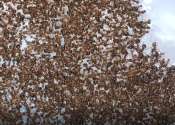Ants are social insects of the family Formicidae (pronounced /fɔrˈmɪsəˌdiː/), and along with the related wasps and bees, they belong to the order Hymenoptera. Ants evolved from wasp-like ancestors in the mid-Cretaceous period between 110 and 130 million years ago and diversified after the rise of flowering plants. Today, more than 12,000 species are classified with upper estimates of about 14,000 species. They are easily identified by their elbowed antennae and a distinctive node-like structure that forms a slender waist.
Ants form colonies that range in size from a few dozen predatory individuals living in small natural cavities to highly organised colonies which may occupy large territories and consist of millions of individuals. These larger colonies consist mostly of sterile wingless females forming castes of "workers", "soldiers", or other specialised groups. Nearly all ant colonies also have some fertile males called "drones" and one or more fertile females called "queens". The colonies are sometimes described as superorganisms because the ants appear to operate as a unified entity, collectively working together to support the colony.
Ants have colonised almost every landmass on Earth. The only places lacking indigenous ants are Antarctica and certain remote or inhospitable islands. Ants thrive in most ecosystems, and may form 15–25% of the terrestrial animal biomass. Their success has been attributed to their social organisation and their ability to modify habitats, tap resources, and defend themselves. Their long co-evolution with other species has led to mimetic, commensal, parasitic, and mutualistic relationships.
Ant societies have division of labour, communication between individuals, and an ability to solve complex problems. These parallels with human societies have long been an inspiration and subject of study.
Many human cultures make use of ants in cuisine, medication and rituals. Some species are valued in their role as biological pest control agents. However, their ability to exploit resources brings ants into conflict with humans, as they can damage crops and invade buildings. Some species, such as the red imported fire ant, are regarded as invasive species, since they have established themselves in new areas where they have been accidentally introduced.









